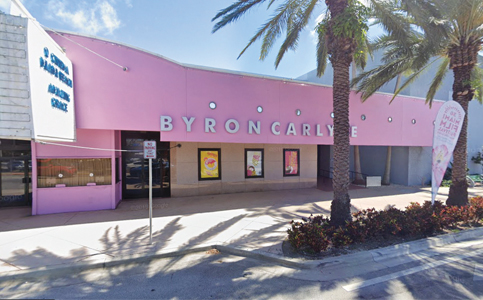Advertisement

A plan to transform the Byron Carlyle Theater in North Beach into a multi-institution artistic and cultural venue emerged in a joint proposal as the City of Miami Beach is in the process of vetting letters of interest from organizations on what to do with the theater.
Last December, the city authorized the administration to seek letters of interest from cultural partners to transform the Byron Carlyle at 500 71st St., between Byron and Carlyle avenues, after the city passed an arts and culture general obligation bond, which funds the project with $30,570,000. In February, the city began receiving responses.
Twelve cultural partners and organizations in total responded, including Area Stage Co. and Theater, Campbell Construction Management, Fantasy Theater Factory, Florida Opera Prima, Loud and Live, Miami Jewish Film Festival, Miami Music Festival, Nu Deco, O Cinema, Rhythm Foundation, Sanctuary of the Arts, and Sterling Bilder LLC, city documents show.
But a separate proposal to the finance and economic resiliency committee last week was brought by David L. Sexton, president of the Normandy Fountain Business Association, with arts providers that have worked in North Beach, including Vivian Marthell of O Cinema; James Quinlan, president of the Bandshell, and founder of the Rhythm Foundation; Miami New Drama executives; Beth Boom from Miami Light Project; Sammy Gonzalez, president of Young Musicians Unite; and architect Roberto Espejo, senior project coordinator at Ennead Architects LLP. The joint group presented a concept that could include five levels of arts workforce housing.
The plan would include a 2,700-square-foot arts gallery on the ground floor, curated by Arts in Public Places to bring exhibitions from Miami Beach galleries and studios, said Mr. Sexton. In addition, it would include a lobby, a café, and a concessions area facing 71st Street; a 200-seat Black Box theater, modeled after the Carnival Studio at the Adrienne Arsht Center for the Performing Arts; a rehearsal studio; a 3,000-square-foot recording/podcast studio and office; and a 350-seat proscenium theater, “which is a [seat] number that is missing in the area for revenue-generating performances,” said Mr. Espejo.
The mezzanine level would have at least 2,830 square feet of offices for arts organizations and non-profits, as well as conference rooms and a shared reception area.
The second level would include two cinemas, one with 100 seats and one with 75; two other smaller cinemas and a teaching studio space; an outdoor terrace event space and adjoining indoor event and rehearsal space.
Levels three through seven would house up to 72 art workforce housing units ranging from 580 to 796 square feet, and a rooftop terrace, “similar to what the New Work Symphony has [in 500 17th St.],” said Mr. Sexton.
The property would be 110,000 square feet, utilizing the floor area ratio allowed in Town Center.
“The Byron Carlyle was an extremely challenging place to produce theater in,” said Mr. Sexton. “The city didn’t talk to many arts providers when it was built. When the $30 million [arts and culture bond] became available, I thought, I don’t want this to happen again.”
The vision for a new Byron Carlyle, according to his presentation, would be a “collaborative, creative hub, with state-of-the-art recording and production studios that would provide audio and visual support for artistic tenants, and a shared open office space for arts organizations and non-profits.”
The proposal would honor architectural traditions of the neighborhood, he added, using the original 1968 design as a frame of reference.
The brick-and-mortar cost of the arts complex – without the workforce housing – would be about $30 million, Mr. Sexton said. “If the city would choose to add the five floors of housing, they would have to find additional funding for that, or a model like the one used in the Collins Park Project, where the housing pays down a bond that essentially pays the project.”
The finance committee sent the proposal to this Friday’s commission meeting. In the meantime, the city is evaluating letters from other cultural institutions interested in what the Byron Carlyle would become. The city is also talking with cultural and art consulting firms to provide input on “what the best and viable candidates to promote the arts in this venue” would be, according to city documents.
“We’ve asked for proposals from four firms,” said Eric Carpenter, deputy city manager. “We’ve got two proposals; we’re waiting on a third.
Then we will evaluate the options. We’re hoping to bring something [Friday] for an award of a contract with an arts consultant to take information from the neighborhood, do some stakeholder consensus, and come up with a good programmatic blend for the building, because we need to identify who our partners are, and what the end goal is, before we can move forward with a long-term vision.”
Since 2021, the city has been engaging with consultants such as ETC Institute, which made a study in September and October to understand community desires for the site.
The study reported that 29.6% of 571 respondents preferred renovating the existing theater and maintaining public access and use. Only 7.2% said they would prefer a demolition and redevelopment via public-private partnership.
Almost half would prefer a combined theater and cinema, about 30% said they would prefer a combination of retail, theater, cinema and housing, 13% said they would prefer a community flex space, fewer than 10% said they would prefer a theater, and only 4.5% said they would prefer a cinema.
So far, $12 million of the $30 million from the arts and culture bond could soon be put in the first tranche to be used for designs and other preliminary processes if the commission approves it Friday.

